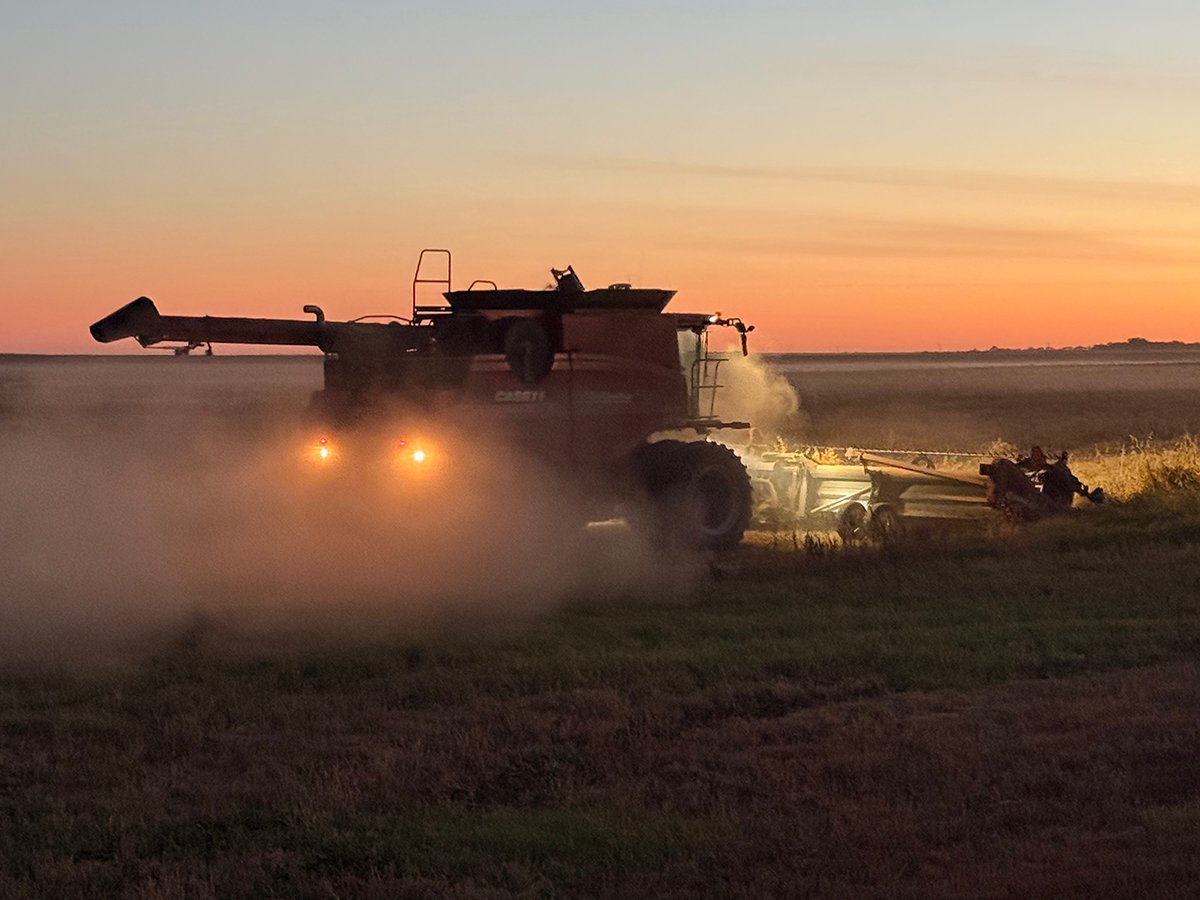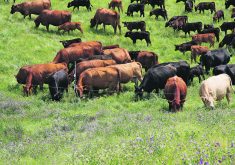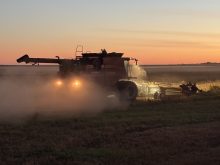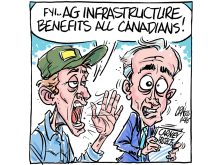Vanclief’s visit
I would like to know why the federal government sent (federal agriculture minister Lyle) Vanclief out to Saskatchewan anyway.
What’s this costing us to have him come out here to tell us they aren’t going to give a disaster payment anyway, and he said that on the news before he ever arrived on Saskatchewan ground.
Did the farmers really expect a payment? He says we should use our crop insurance and Net Income Stabilization Accounts, but NISA isn’t always easy to access, as they base your off-the-farm income in the averaging so you can’t trigger your cash anyway.
Read Also

Downturn in grain farm economics threatens to be long term
We might look back at this fall as the turning point in grain farm economics — the point where making money became really difficult.
The NISA should not be based on your off-the-farm income because people that work off the farm are already subsidizing the farm and now you’re getting penalized again by not being able to trigger your NISA.
I’ve watched for many years, when the government gets into these programs, it is buyer beware, as these programs do not help the people that it’s intended to help. It only helps the government to hide in more corners.
The federal government doesn’t need farmers. All they want are the corporations, Bombardier, etc., so maybe we should all move to the cities and play golf. Have the farmers or anyone else had an increase in salaries of 21 percent to 42 percent? The farming income has decreased and the middle class gets two percent.
The farmers are getting hosed good and proper, and we take everything the government says as gospel. We’re too laid back but what do we do when we’re a minority?
– Elaine Cozart,
Brownlee, Sask.
ID program
Mr. Archie Shaver has complained previously about the National (Cattle) Identification program. He is actually right about a few things.
The program was not popular at the outset but as producers began to appreciate how dependent our industry is upon consumer confidence at home and market access abroad, and saw the devastation caused by diseases like foot-and-mouth and mad cow disease in Britain and elsewhere, most became convinced that national ID was a small but necessary price to pay to protect their livelihoods.
He is right to point out that introduction was not smooth. Of course it wasn’t.
It has been a major effort and we have had our share of glitches, including determined resistance and misinformation from people like Mr. Shaver.
But they are being worked out and we are on target. Most of the larger packers began to read tags in packing plants on schedule on July 2.
Mr. Shaver thinks that because there are 18 brands of tags, the numbers are sure to be duplicated. A different series of numbers is allocated to each manufacturer by the CCIA and so will not be duplicated.
Mr. Shaver questions the claim that 8.3 million tags have been sold. So would we. No such claim has ever been made. Instead 8.3 million tag numbers have been allocated to manufacturers and 3.3 million have been reported sold.
That is a very impressive number, considering that our beef calf crop is only about 4.4 million per year. Not bad at all for a program that is only half way through its first year.
Mr. Shaver says that only five percent of producers in British Columbia have co-operated with the program. We wonder if he isn’t confused by the fact that about five percent of the tags reported sold are to producers in B.C., and that is pretty close to the proportion of the national herd in B.C.
Mr. Shaver feels that if more producers had resisted the program, it might have failed. He’s likely right about that. No program can long survive without producer support and there isn’t an army big enough to enforce it if producers are determined to resist it.
We knew that going in. But it looks like the majority of producers care about their industry and their livelihood and have decided that they should support the program.
No, things haven’t been smooth, Mr. Shaver, but producer support and participation and packer co-operation is very impressive and encouraging despite the active resistance from a few people like you.
National ID may never be terribly popular but it is one of a few things we need to do if we wish to retain our standing as a world-class producer and exporter.
– Brad Wildeman,
Canadian Cattle
Identification Agency,
Calgary, Alta.
Real reasons
Recent headlines ‘Revolutionizing the Farm’ appeared in the Edmonton Journal (June 6) and the National Post.
The article states “The Chrétien government plans a sweeping overhaul of national farm policy aimed at ending recurring emergency cash bailouts and improving farm income through better technology, training and crop diversification.”
The article further states “Almost half of these farms lost money in 1999 despite government income support. Low commodity prices are to blame and are caused by global overproduction in grain and edible oilseeds.
“We need to change the conversation away from government income support to increasing income from farming,” says one senior official. “We need to brand Canada as not just better, but best, and that means being able to clearly document where our food comes from and what farm practices are in the production process.”
Federal agriculture minister Lyle Vanclief is discussing these proposals with his provincial counterparts at major federal-provincial meetings on the new policy direction to be held later this month and in September.
For some unknown reason, these news articles did not appear in farm newspapers such as The Western Producer or Manitoba Co-operator. Could it be that the Feds are trying to misinform urbanites about the real problems in farming (and their role in these problems), and at the same time not give farmers a chance to rebut their flawed analysis?
What is not being discussed is the real reason farmers are going broke. Farmers have lost most programs that gave them some control over their own destiny.
Some programs lost: oats cut from CWB; import controls on oats lost; two-price wheat system cut; branchline rehabilitation program eliminated; Western Grain Stabilization program eliminated; import controls lost on ice cream and yogurt; Plant Breeders Rights legislation enacted, while research and development cut; wine industry eliminated; variable freight rates enacted; Meat Import Control Act not enforced; increased import quotas for chicken eggs, turkey; cost recovery programs; seed growers inspection costs raised; higher inspection costs for Canadian Grain Commission inspection services; changes to Income Tax Act; elimination of five-year block averaging provisions, investment tax credit on new farm equipment eliminated; countervail on hogs and pork; introduction of GST; transportation subsidy on canola oil and meal to west coast ports eliminated; Canagrex eliminated; loss of tariff protection for horticulture industry; loss of Crow Benefit and implementation of the Free Trade Agreement.
Add to this the massive elevator closures by our ‘friends’ the Saskatchewan Wheat Pool, and you have the real reasons farmers are going broke. These were lost due to corporate pressure on our governments and are the real reason farmers are losing money.
Corporate domination of inputs such as fuel, seed, chemicals, farm machinery and transportation are the culprits. Genetically modified organisms are certainly not the answer, as suggested.
That only leads to more corporate control over food quality and availability. If there is such an oversupply of food, why do we have millions of people starving worldwide and even in Canada?
But hey, capitalist governments thrive on corporate control, and for some unknown reason people, even those being exploited, keep electing them.
– Joyce Neufeld,
Waldeck, Sask.
Effective marketer
First, I can assure Mr. (Russell) Larson that the Canadian Wheat Board sells into many markets, including the United States, at premium values. John Miller, President of Miller Milling Co. and spokesman for the North American Millers’ Association, confirmed this in testimony before the International Trade Commission.
Mr. Miller said, “Most of the time, the Canadians are more expensive than the United States.”
In a further question, Mr. Miller went on to say, “I think the reason is that the Canadian Wheat Board is attempting to optimize returns for their farmers. The U.S. grain market, in general, is more concerned about the margin that they earn on a per bushel basis, than they are in trying to optimize the return to any one farmer.”
Incidentally, Mr. Larson actually quoted from this same transcript in his original letter (Open Forum July 12.)
I can only assume he did not see this part of the transcript.
Second, it is true that CWB market share has remained at about 20 percent for a number of years. Based on Mr. Larson’s comments, it is fair to say he considers market share to be a measure of performance and he would prefer a system free of the CWB, such as the U.S. system.
The U.S. global market share in wheat has slipped from 32 percent in the past decade to 25 percent today. The mission of the CWB is to maximize returns of western Canadian farmers, which is not always consistent with maximizing market share.
Third, Mr. Larson notes that CWB staff do not work in the real world nor do they consider customer service important. Mr. Larson notes the growth in the pulse industry as evidence.
Our family farm in west-central Saskatchewan has shifted acres into pulse crops in recent years. This acreage shift has occurred in part due to the nitrogen-fixing ability of some specialty crops and the agronomic benefits associated with these crops.
To assume the type of marketing system is the only reason for increased pulse acres is flawed. Why are canola acres, which are marketed on the open market, down 18 percent this year? Does the canola industry know nothing about customer service?
– Rick Steinke,
CWB Marketing Manager,
Winnipeg, Man.
Charges
A recent letter from Ken Ritter suggesting I requested more marketing choices from the Canadian Wheat Board is a joke. The choices I prefer do not involve the CWB. The marketing options he refers to are another joke. Why?
Our wheat prices are based on the Minneapolis future, which has a built-in U.S. freight and handling charge. Then the CWB has the audacity to subtract a similar Canadian charge from our cheque. Double freight on top of risk, time and administration charges ranging as high as 67 cents a bushel is not my idea of a healthy diet.
Ask yourself why only one-half of one percent of our wheat was marketed through their PPO program? That’s right, most farmers are smarter than that.
– Louis K. Berg,
Sedalia, Alta.
Education tax
I recently attended a high level NDP function in which the education tax on property was a big issue brought to the floor four times by four different people.
One of the crown’s ministers showed considerable aggravation about our continued effort to prove to the government that this was indeed a very unfair form of taxation, since land owners end up paying a larger portion of tax even if their businesses are going under.
She proceeded to attack me as a farmer, saying that I was being considerably subsidized already by the Saskatchewan government. I would say helped by the Saskatchewan government. Subsidized, I will disagree with, at least not while I have been farming.
In fact, my view is that I am the one subsidizing the rest of this country lately.
How can you accuse me of being subsidized when the Canadian public is still buying bread in its stores for the same price it paid for that bread 20 years ago?
And I am powerless to get that price raised. My costs are greater than my income to produce that bread, yet I cannot demand more of my market.
Other businesses would simply pass the increased costs on to the consumer. I cannot, due to the federal government’s control over me through the CWB.
How can you accuse me of being subsidized, when the millers of flour have never needed to increase the cost of that loaf of bread because governments in the industrialized world are constantly securing a cheap supply of grains for them?
In Canada through the CWB contract system, a farmer must commit his grain for guaranteed sale without receiving any price guarantees or he cannot sell it.
Yet once he commits to that sale, he has no say in what price he will receive, and in fact may not find out that price till well after the crop is seeded and harvested.
How can you call me subsidized when the initial price that a farmer receives from the elevator system for grain sold is in the neighborhood of $1.50 less than what I need to pay my bills?
To me this sounds like I am subsidizing the CWB till they give me my final payment 18 months later. …. …
The people of Saskatchewan can help farmers considerably by removing one of the subsidies he must pay and by sharing equally in the cost of education.
It is only fair. If education were put on the income tax system, or even as a flat tax, about $250, everyone would share the burden of education. What that would do to help the farmer is immense.
We are all aware that the farmer pays two main taxes. One is tax on income as everyone else does and the other is tax on land, which, if not paid, can result in land foreclosure. The education tax on land consists of about 52 percent of the average figure of about ($7,000) for municipal taxes.
So by getting education tax off farmland, you would give an average farmer an extra $3,500 to pay his bills with and you would eliminate much of the risk of him losing his land to tax reinforcement.
So as Dr. Laura would say, “go do the right thing” before it hurts the family farm to the point that they have to become corporate farms in order to survive, because we all know there are no subsidies when it comes to corporate earnings.
– Ivan Costley,
Mossbank, Sask.
Healthy plants
I read with great interest your recent article by Karen Briere entitled “Shelterbelt spawns health bar idea.” It is quite clear that Morris Johnson is on the right track with his identification of various plant components that are evidenced to maintain or promote good health and combine them into an edible product.
In fact, as time goes by, I think that much more attention should be, and will be, paid to modifying or supplementing our diets with such products. In addition, the use and promotion of shelterbelts in agriculture provides a natural springboard for the launch of many more similar products.
What could be a better way for a farmer to supplement his or her income by providing a diversity of foodstuffs with high nutritional value?
Although I appreciate Professor Juurlink’s critiques about Morris Johnson’s Lifespan bar, I would say that, in fact, there is some evidence supporting the antioxidative effect of some of the components in Morris Johnson’s bar. In our own nutrition and oxidative stress lab here in Oslo, we have shown how many plant flavenoids (such as found in blueberries, for example) can increase antioxidant levels in both test tube experiments and in animal, including human, trials.
I would encourage Mr. Johnson and like-minded people to continue the expansion of these kinds of farming and business interests and I also applaud Prof. Juurlink’s open-mindedness and interest in the health maintaining and improving qualities of many plant varieties.
– Dr. George Alexander,
Johan Throne Holst’s Institute for Nutrition Research,
University of Oslo,
Oslo, Norway
Biotech benefits
In the July 5 issue of The Western Producer, the headline of Ed White’s article “Production, not profit, the real biotech payoff?” implies that the only benefit from biotechnology in canola has been increased production.
Unfortunately, the rather lengthy article only allows three sentences to the fact that biotechnology has financially benefited farmers, but spends the rest of the article justifying the headline.
To date the Canola Council of Canada has the only study that has generated hard facts about the agronomic and economic assessment of transgenic canola in Western Canada.
The data this study collected from western Canadian canola growers clearly shows that growers received an average of $5.80 per acre increase in net return (revenue less input costs and labor). Revenue was reported higher due to increased production per acre and reduced dockage. Herbicide and tillage costs were reduced, while seed cost, (including the TUA), and fertilizer were higher. The benefit of not watching your soil blow away was not included.
The total direct economic impact to farmers was in the range of a positive $144 to $249 million. The indirect benefit, such as added investment in crushing capacity, impacts on seed, herbicide and equipment dealers, and the transportation industry was another $215 million. The study also confirmed what most in the canola industry take as a given: the acres of soybeans in the U.S. has a greater impact on the price of canola than the production of canola in Western Canada.
In fact, it was determined that the production of canola in Western Canada has no significant impact on the price of canola.
Western Canadian canola growers adopted this technology very quickly for simple reasons: it generated agronomic and economic profits.
– Ward Toma,
Alberta Canola Producers
Commission,
Edmonton, Alta.
















